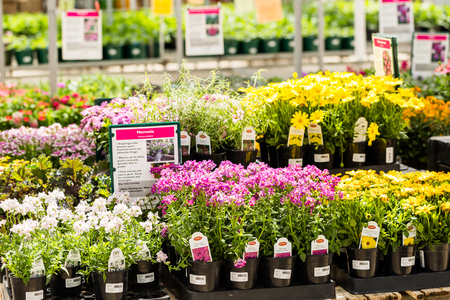The opportunities of AI
Artificial Intelligence provides the gardening industry with plenty of opportunities: retailers and suppliers can use AI to improve their business, services and products. However, during the Spoga-Gafa and GLEE in June, we noticed that many companies still have no idea about the possibilities of AI. Admittedly, it is also sometimes hard to understand if you don't know your way around tech jargon. However, that should not be the reason not to embrace AI!
To avoid missing out on opportunities, we have listed some practical examples for you below. You will see that AI is easy to deploy, and the applications are endless. We have included all the information and links below so you can get started right away!
1. Photos with pets
During Spoga-Gafa, we spoke with Beeztees. They make toys for pets, and their challenge is to take the "perfect" photo where the dog, cat or hamster looks well into the lens while he (or she) is playing with the newly developed toy. A tricky job that sometimes takes hours, we are told.
Thanks to Drag Gan, that's now a thing of the past, as this technique allows you to set each pet's face just right. Just watch this video to see how this works:
Drag Gan was developed by a number of universities and is available for free. Check out this page for more information.
2. Product concepts
At the same Spoga-Gafa, we stood in between the stands of Capi, Esschert and Ter Steege. All of these suppliers introduced new products on the tradeshows. Developing a new product can take a long time and cost a lot of money. You have to develop an idea, work out a concept and then produce the product.
With tools like Midjourney, you can have any idea turned into a concept within seconds so that you immediately get an idea of how it will turn out in reality.
If Esschert wants a new birdhouse in fancy colours or shapes, Midjourney comes up with a number of possibilities within 30 seconds:
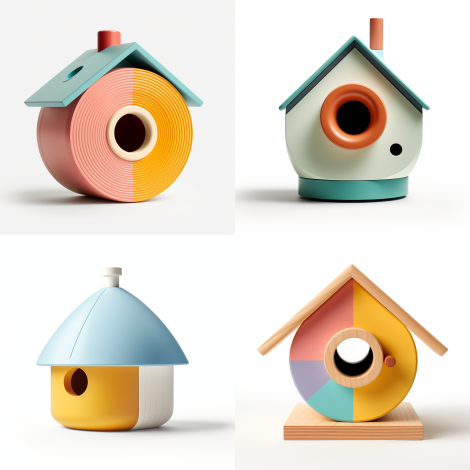
Standing next to us at the Spoga-Gafa was Capi. Coming up with new designs for pots is not always easy. Even for this, Midjourney gives plenty of suggestions to make it into something fun. For example, take a look at this pretty pink pot in Capi-style:

Of course, with Midjourney's suggestions, coming up with a new design goes a lot faster than having several product designers think about products, make sketches, etc. In the end, you will always need product designers, but coming up with a concept is now a lot easier.
Now you can immediately assess whether a pink Capi pot is worth developing at all...
3. Garden centre concepts
At GLEE in Birmingham, our stand was close to Smiemans Projecten, they are designers and builders of beautiful garden centres. How can they give owners an idea of a new, innovative garden centre concept? Here, too, Midjourney can help. Take a look at this idea:

This garden centre facade is at least more innovative than the standard facades found throughout the UK (and far beyond). Whether it is price-wise interesting to build, we do not know, but at least you can suggest designs and show designs that deviate from the beaten path.
Incidentally, you can also specify very specific requirements. This is the prompt I entered at Midjourney:
Can you make a photorealistic shot of a modern garden centre greenhouse in natural environment. One level only. The size is 120 x 40 metres. Entrance in the middle of the building. Parking in front of the entrance. Modern building with round cornered rooftop. Birds eye view with drone. Wooden elements on entrance. Large outdoor plant area. Use existing but innovative garden centre designs. Garden centre parking has lots of plants.
And the result is something that will no doubt make Smiemans happy if they get to build it:

4. Retail concepts
Whereas we came up with a lot of garden centre concepts with Smiemans, LookInSight was next to us at Spoga-Gafa, and they focus more on the inside of the centre. Innovation on the shop floor and optimising returns is their area of expertise. But what kind of innovative retail concepts are out there right now?
We once asked OpenAI for some suggestions, and these were the innovations they think fit in a garden centre:
- Virtual reality experience, allowing customers to visit their own future garden digitally.
- Robotic assistants, to answer questions in-store. (So, a good combination of a robot and our own BloomBot!)
- Plant subscriptions, so customers get a beautiful houseplant delivered to their home every quarter
- Green recycling, taking back and reusing all materials, including the plants
- Smart Garden Station, an information point where all information around smart gardening comes together, including a test garden (robotic mowers, lighting, microdrip, etc.)
- Adopt-a-plant programme, where customers can adopt and care for a plant.
That’s a good list for such a simple request. We think the Smart Garden Station is interesting because it links innovation and automation to knowledge and explanation.
Moreover, this product group is rather underexposed in the garden centre while the products are often expensive - and therefore good for sales!
You can ask OpenAI for more information on this concept, for instance, by asking the following questions:
- Can you explain to me more about how I can apply Smart Garden Stations in my centre, what added value it offers to my customers and why I should do this?
- Which products and brands are a good fit?
- How can I best involve my employees in this?
- etc.
You have to look critically at what information you get from OpenAI, but it's hard to deny that you don't get creative suggestions when you want to apply something new in your shop.
By the way, you can also turn it around and just ask for the best proven retail concepts and imitate them, but we simply like innovation more than copying!
5. Combining ChatGPT + Midjourney
So, now we have a concept that was generated by OpenAI. The question is what that will look like on the shop floor. After all, that's what LookInSight is figuring out for retailers.
The trick now is to combine ChatGPT with Midjourney. Sound complicated? It isn’t!
After asking ChatGPT to work out the Smart Garden Station, we also take a moment to ask for advice on creating good instructions for the picture. You do that with a question like this:
I want to visualise the smart garden station. To do this, I am using Midjourney. I want a photo-realistic representation of a smart garden station in my garden centre. Name products that are there. Provide a full, complete Midjourney prompt for this in English.
You will then get a good explanation from ChatGPT that you can copy into Midjourney. The result of the image you then get is shown below:
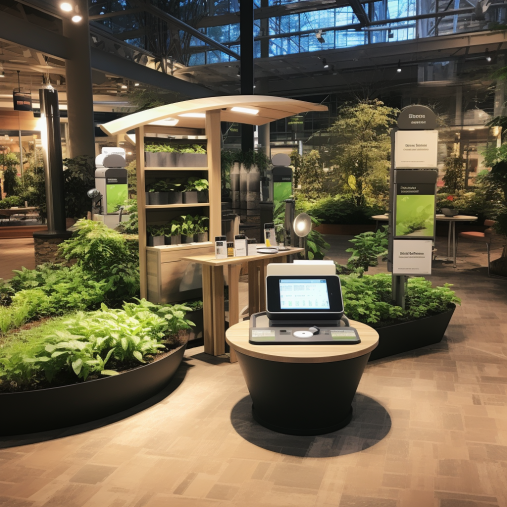
This way, you can develop and visualize a concept or idea without having to go through all kinds of complex processes. For the first "brainstorming" phase, this obviously works fine!
6. Shop music
Playing music in your garden centre is important to boost the atmosphere but can be expensive. The alternative is to subscribe to royalty-free music, but then you shift the cost from one company to another.
Thanks to AI, you can now make your own royalty-free music in no time. Or just music you like to hear yourself, of course. If you take a look at Soundraw.io, you can instantly create something you think suits your shop.
For a shop, you obviously want something that is positive and puts people in the buying mode, so try this:
- Genre: Acoustic, Electronica
- Mood: Happy, Hopeful, Glamorous
- Theme: Motivational & inspiring
- Tempo: Normal
- Instruments: anything but synths, because we're not living in the 80s anymore
That will take you at least a minute to set up, and voila, here's your own playlist of music to use. Of course, you can change this by season and theme.
By the way, Soundraw.io doesn't let you get a voice in it. Disappointed? Then head over to Uberduck.ai. Here you can make Freddy Mercury say he likes going to your garden centre!
7. Creating content
Of course, you can also use AI to create content. By now, ChatGPT is the most well-known party for this.
Having AI to create content sounds easier than it is because you have to pay attention to whether the information you get from AI tools is correct. One nice tool you can use is https://ask.writer.com/. With this tool, you can easily get different types of content written.
For example, the tool lets you summarise articles with one click. Or it gives you a list of frequently asked questions based on a page on your website. Pretty handy! However, you should always check if the information is correct because sometimes AI gives you the illusion that something is correct, but it doesn't have to be.
For example, if you ask ChatGPT the following:
"Give me 5 scientific facts about the importance of good in-store signing for garden centres".
Then you get a list of facts with a link for each source mentioned. However, if you click on the links, they usually don't exist at all!
Another great tool is simplified.com. It lets you create a presentation on a topic within one minute. For example, see below the presentation I made on "Innovative Garden Retail Marketing Ideas". It was a piece of cake, and the ideas were quite fun:
You can never copy everything directly, but it works great for getting ideas and presenting them. Perhaps to your manager, but then you have to hope he or she hasn't read this article!
8. Use for social media
You can cross the boundaries of reality with AI, which can sometimes be frightening, but it is also great fun. Especially on social media. We ourselves made a photo series of well-known politicians shopping in garden centres:
We got a lot of reactions to this, precisely because it looks realistic, but at the same time was not realistic, of course. On social media, you can do lots of fun things with this. For instance, ask your followers which houseplant this is:

Feel free to promise the winner a new car because the plant is (of course) completely fake. Another plant that will attract attention is this candy plant, because every child probably wants to buy it at the garden centre and put it in the garden:

With a little creativity, you will attract a lot of attention on social media, so do your best!
9. Data analysis with AI
Those texts and photos are fun, but what else can you do with AI? A simple tool to analyse data is DeepSheet. You simply upload an Excel file with raw data and then ask questions. I myself did this with an Excel file of transactions in an online shop of our customers.
The questions & answers:
- How much shipping costs have I charged customers in the Norwich area?
Answer is £279.60 in total. This question can help determine whether you need to adjust your shipping regions. - Give me the average weekend order value.
Answer is 27.25%. - What is the average purchase value of my 5% best customers?
Answer is £373 - which, by the way, is not bad for a webshop that only sells plants!
See how easy this is here:
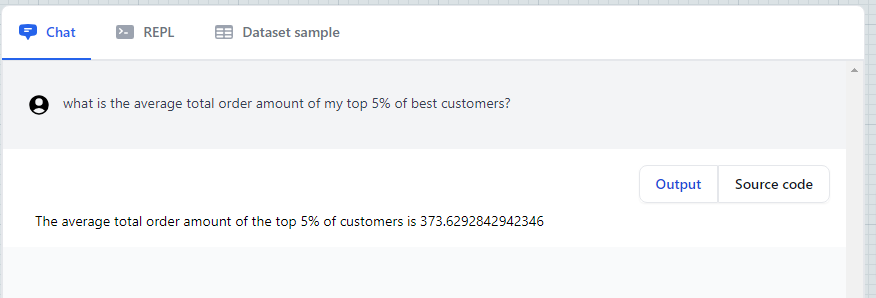
This tool is free to test, so feel free to check it out. It is a good way to go through datasets that are not well structured and ask questions in a natural way. This tool is quite limited, but it shows the power of AI. Other tools are more expensive but can also do a lot more.
10. Customer service with BloomBot
Finally, we want to present our own AI-powered chatbot to you: BloomBot. We introduced our BloomBot at the Spoga-Gafa and GLEE (in Birmingham). For our own chatbot, we use three layers:
- The foundation is OpenAI
- On top of that, we have added a database of more than 50,000 plants with information, tips and information.
- Finally, we index our customer's website so we have up-to-date knowledge about products, opening hours, etc.
That combination allows you to have a conversation with a virtual garden centre employee. The conversation is organic, you can ask whatever you want, and BloomBot almost always knows what to answer.
For example, many customers have questions about gift vouchers. BloomBot gives the answer based on the information on the website, and refers the visitor to the most relevant page on the website if possible:
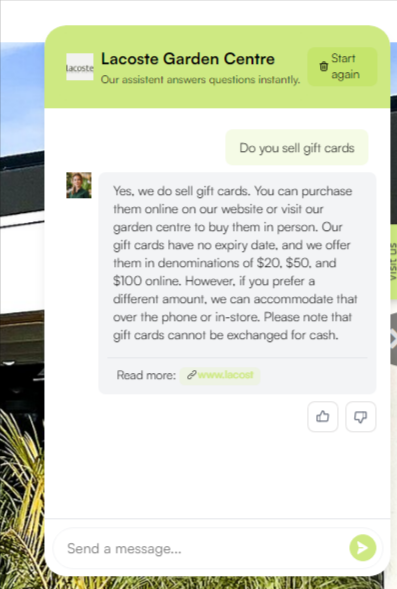
As mentioned, BloomBot also has plant knowledge, for example, about cutting back your Monstera:

And of course, we make sure that the BloomBot can only answer relevant questions:
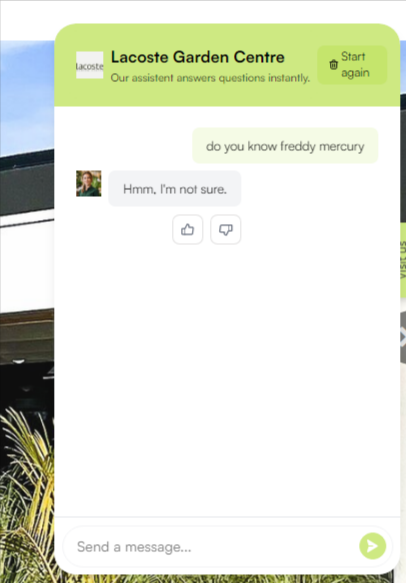
Previously, you had to train chatbots and provide them with the right information. By linking our plant database to OpenAI and using all the information from your own website, you get a chatbot that can be deployed within minutes and saves valuable time. After all, you will receive fewer e-mails and phone calls with questions!
Costs & objections to AI
Innovation is often expensive, and AI is not necessarily an exception. However, everything we explained above you can do with online tools that cost less than $50 a month combined. If you want to try more advanced solutions, it quickly becomes more expensive.
The most precious thing you need to get started is time: the cost of the technology is extremely low and makes it interesting for anyone to use.
But we know entrepreneurs in the gardening industry, and the objections there are:
- I don't like the texts that are written
- It is scary to use
- It's too expensive (which is so not true!)
- I don't have time to look at this
I'll grab an easy example to disprove that last one immediately: It's like walking with a bicycle in hand. If you take three seconds to get on it, you'll get from A to B a lot faster! And that's exactly what's going on: everyone has access to AI, but many entrepreneurs (and employees) don't take the time to learn how it can help them save time.
You hear all kinds of things about the danger of AI - even that AI developers want it stopped! That, of course, is a marketing story. It would give the companies who now own the knowledge of AI a monopoly: because what they have, another company is not allowed to develop anymore!? That's the world upside down, but sounds tasty, especially when it appears in a serious newspaper. But nonsense it is for sure.
Future of AI in the garden industry & beyond
To use another English proverb: you can't unscramble an omelette. And the same goes for AI. It is here now, and everyone can use it, so let's use it for the most part in a positive sense.
The examples above will show you how you can get started today on conceptualization, saving time and working out innovative ideas—no matter what kind of business you have. AI makes our lives easier and more enjoyable, as many tasks are taken out of your hands, and you can quickly boost your creativity.
The opportunity is there, it's up to you to get the most out of it!



